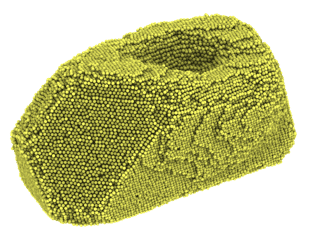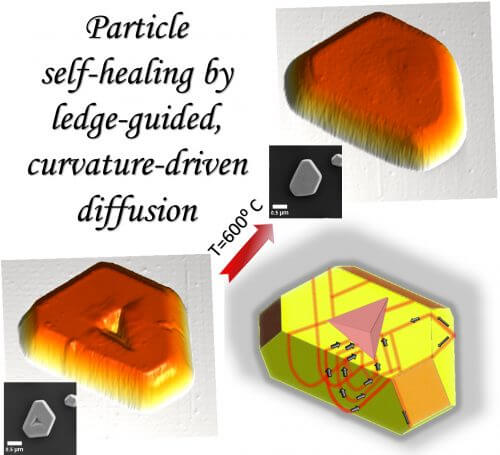Scientists at the Technion and in Germany demonstrated for the first time "shape memory" in gold particles.

Researchers from the Technion and Germany demonstrated for the first time the phenomena of shape memory and self-regeneration in micrometric gold particles. This is through diffusion directed by defects in the particle. The study, which was published last Friday in the journal Advanced Science, was conducted by doctoral student Oleg Kovalenko and Dr. Leonid Klinger under the direction of Prof. Eugene Ravkin, Dean of the Faculty of Materials Science and Engineering at the Technion, together with Christian Brandel from KIT (Karlsruhe Institute of Technology, Germany).
Shape-memory materials are characterized by the fact that they are able to repair the damage caused to them (eg distortion, deformation) and return to their original shape. These materials have two aggregation states (phases): austenite, which is its more symmetrical and orderly initial form; and martensite, which is an aggregation state characterized by disorder and asymmetry but also by greater strength. A familiar example of the transition between the two states is the creation of tempered steel.
The transfer of the material from the austenitic aggregation state to the hardened, or martensitic, aggregation state is done by applying mechanical force to the material or by cooling it. The asymmetric structure of the martensite allows the material to absorb large plastic deformations in that the crystals of the material line up according to the direction of the load applied to it. Even after plastic deformation, the crystals "remember" their original state, the austenite, and strive to return to it. This aspiration will come true if we heat the material, which will turn the heat energy into mechanical energy that will return the material to its original state.
To date, the shape memory phenomenon has only been observed in unique metal alloys such as Nitinol (Ni-Ti). These alloys are characterized by polymorphism - multiple possible crystalline aggregation states. Now, for the first time, the phenomenon has been demonstrated in sub-micrometer gold particles. The researchers "stabbed" the gold particles with a diamond needle, and this under an atomic force microscope (AFM). The particles returned to their original shape following heat treatment of the pierced particles at a temperature of 600 degrees Celsius - about 65% of the melting temperature of gold.

The discovery of the shape memory phenomenon in these particles is surprising, according to Prof. Rabkin, for two reasons: "First, the original shape of the particles was not 'perfect' in terms of energy and equilibrium and second, gold in its solid state is not characterized by polymorphism."
In order to understand the process in depth, the researchers examined the atomic movement both during the piercing and during the heating, using atomistic molecular dynamics simulations on the computer. They showed that the deformation created during piercing is mediated by the nucleation and glide of dislocation loops - one-dimensional defects in the crystal through which it undergoes plastic deformation. The dislocations form steps on the surface of the particle, and these steps serve as a kind of "guide rails" that lead the gold atoms back to the aqaba (the stab site) in a process of high temperature diffusion. This is how the particle returns to its original shape.
Particularly interesting is the fact that while plastic deformation and diffusion are classic examples of irreversible processes, the combination of them can eliminate the same irreversibility and lead to a complete recovery of the particle shape. To understand how surprising this process is, think of coffee spilled from a cup and then it jumps off the floor back into the cup or of a car returning to its original shape after a total-loss accident. According to Prof. Ravkin, the discovery of the shape memory effect in nanometric and micrometric metal particles may help in the design and creation of submicrometric components and devices that will be stable and immune to damage. "We all know, for example, the charging failures in smartphones that result from the wear of the area to which the charging cable connects. Making this area from materials with self-healing ability will prevent the said erosion and the need for repair. Another possible use is the controlled transport of drugs to the targets in the patient's body, by introducing a drug into the heel, which will expel it out following heating."
For the full article in Advanced Science click here

One response
That's right - I once received such a spring from "Metchat Zochrot" - when you stretch it into a wire it remains a wire, when heated it returns to the shape of a spring.
At the time in the startup company where I worked, they wanted to use it for stents (springs that support the arteries), you insert such a spring in an aligned position into the artery and the heat of the body turns back into a spring that supports the artery wall. (don't know what happened to it after you)
It is also possible to produce such spoons that are normally bent, and you can straighten them, and then with a slight heating they bend back - can be useful for magicians bending spoons.